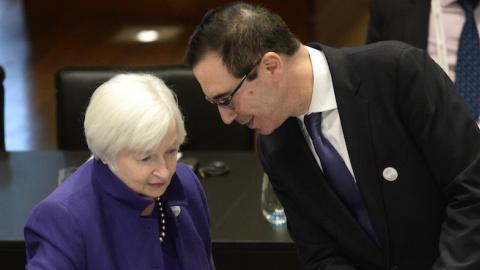We're now three months into the new administration and more than a year on from the start of a powerful late-cycle monetary stimulus (otherwise described as "the Yellen Put" in which all planned rate rises for 2016 were halted) by the Federal Reserve. But, we haven't heard a whimper from the Republicans over the Fed's extremely timid efforts at ending it's ultra-easy-money policy. They have been focused instead on Ryancare and the border adjustment tax. Meanwhile in the marketplace the Fed-watchers are back to business as usual -- deciphering every word and dot plot change from the leading monetary bureaucrats still at their posts.
Counter-factual historians can wonder how different and better the situation might now be if conservatives and nationalists had begun the Trump era with efforts to rein in the Fed. Instead, what we got was an aborted repeal-and-replace of Obamacare and now a planned "tax reform" that still appears far off on the horizon. Yes, any monetary reform bill would have faced most probably a filibuster in the Senate, but the president has the power to at least point us in the direction of sound money by filling the empty chairs in the Fed and nominating successors-in-waiting to Professors Fischer and Yellen.
What Trump Should Have Done
Several markets deeply infected by asset-price-inflation might indeed have experienced steep drops in speculative temperature. But an accelerated end phase to the present great inflation (most prominent in asset markets) with its roots in the Great Monetary Experiment could have been blamed on the preceding administration.
That might well have been a superior political strategy to allowing the Obama Fed to enjoy a new lease on life after the exit of its appointing president. Instead, the Fed freely sought to extend the Indian summer in asset markets (consistent with two tiny hikes in the official money rate which signal "success" for its inflation targeting).
But the Trump administration seems to be fine with this and has been taking credit for continued asset price inflation as reflecting business and consumer optimism about its policies. Trump has been taking advantage of the present growth cycle upturn stimulated by the Yellen Put of 2016 to pump up credibility of his growth target which makes absolutely no allowance for a recession further ahead.
The Polyanna-ish Assumptions Behind Trump's Tax Plan
Moreover, Trump's assumptions of continued growth play an essential role in the budget arithmetic which will be used to demonstrate that Trump's proposed tax cuts are fully funded, even given the planned increases in defense spending and no rollback of Obamacare entitlements.
The core of the reform is a slashing of the headline tax rate on domestically generated corporate profits together with a "modest" levy on profits from low-tax foreign jurisdictions. The conservatives are ready to go along with these as part of a general trimming of marginal tax rates which would be in line with supply-side reform of old dating back to the Reagan era. There is much wishful thinking here.
In fact, a bold corporate tax cut unmatched by spending cuts is a parody of supply-side reform. Individuals can look through the sham and see that taxes will rise in the future, or that inflation tax will be levied by stealth.
Yes, the corporation tax changes should induce increased demand for labor in the US as part of an induced repatriation of economic activity. But this will go along with a boost to domestic wage rates and ultimately a shrinking of pre-tax profit margins in aggregate across the US economy. In effect, the tax changes amount to a subsidy regime which would shelter profits from erosion as a protective layer is put in place for domestic labor.
Lessons from Europe: Shifting the Tax Burden
When implemented in this way, lopsided cuts in corporate tax rates can become a source of economic inefficiency and inequity. The problem stems in part from incentives created to retain profits rather than distribute them (as would occur if personal tax rates do not fall in step with the headline corporate tax rates), and in part from ultimate tax burden shifting to pay for the cuts. Look, for example, at how the "race to the bottom" on corporate tax cuts has played out in Europe.
The UK boasts of one of the lowest corporate tax rates (headed to 17 percent in 2020); and yet the effective marginal tax rates elsewhere in the economy (taking account of cuts in deductions) have been increasing. A recent study by the Daily Telegraph showed that the top 1 percent of income taxpayers now pay nearly a third of all income tax; by contrast under the notoriously high tax regime on the eve of Margaret Thatcher becoming PM, they paid just 11 percent of the total.
Make Government Smaller -- Don't Just Favor Certain Special Interests
There is much talk of benign global tax competition unleashed by corporate tax cuts. But the competition which matters is that which tames big government and causing a general revulsion against personal (including consumption and capital) tax rates. Historically though, in the Reagan and Thatcher era, the decisive competition was that between the onshore economies and the offshore world of which London was the center.
In that era, national tax revenues could be bolstered by a lowering of high marginal rates as this would reduce the incentive for tax arbitrage between onshore and offshore. This arbitrage has largely been shut down in recent years. In consequence, governments in high tax jurisdictions have tremendous new power to apply high marginal rates across the board
Big cuts in corporate tax rates driven by a nationalist race toward the bottom might turn out to favor mainly the receivers of high rental income (subsumed under corporate profits) whether stemming from crony capitalism, or monopoly power, or too-big-to-fail bailouts. Many critics see the strong rise of corporate profits in this cycle as in part reflecting the weakening of the power of new entrants into the marketplace -- thanks to a tax burden and regulatory burden that falls especially hard on start-ups and small businesses. Bold cuts in headline corporate tax rates do nothing to remedy that situation. Indeed it may become worse.
















